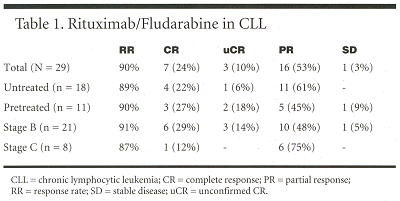Rituximab/Fludarabine Combination Feasible in CLL
COLOGNE, Germany-Combining rituximab (Rituxan) with fludarabine (Fludara) is a feasible, effective strategy in treating chronic lymphocytic leukemia (CLL), as it produces a 90% response rate and does not increase infection risk beyond that seen with fludarabine alone, Holger Schulz, MD, reported in a poster presentation at the 43rd Annual Meeting of the American Society of Hematology. Dr. Schulz is in the Department of Hematology/Oncology at the University of Cologne, Germany.
COLOGNE, GermanyCombining rituximab (Rituxan) with fludarabine (Fludara) is a feasible, effective strategy in treating chronic lymphocytic leukemia (CLL), as it produces a 90% response rate and does not increase infection risk beyond that seen with fludarabine alone, Holger Schulz, MD, reported in a poster presentation at the 43rd Annual Meeting of the American Society of Hematology. Dr. Schulz is in the Department of Hematology/Oncology at the University of Cologne, Germany.
Rationale and Study Design
"Fludarabine is generally considered standard first-line therapy for CLL, producing response rates up to 71%. However, most of these patients will relapse, and a significant proportion of CLL patients will not respond to fludarabine at all," Dr. Schulz said. "The rationale for combining rituximab with fludarabine includes single-agent efficacy of both drugs, possible synergism of rituximab and chemotherapy, and no apparent overlapping toxicities."
The report included 29 patients treated with fludarabine at 25 mg/m²/d (on days 1-5, 29-33, 57-61, 85-89). The first two infusions of rituximab were given together with fludarabine on days 57 and 85, while the following doses (375 mg/m²) were given on days 113 and 151. Eighteen patients were previously untreated, and 11 had previous chlorambucil/prednisone. Twenty-one patients had stage B disease, and 8 had stage C.
The overall response rate in 29 evaluable patients was 90% (see Table 1), including 7 complete responses (24%), 3 unconfirmed complete responses (10%), and 16 partial responses (53%). In previously untreated patients, 16 of 18 responded (89%). The median time to progression has not been reached after a median follow-up of 6 months.

Toxicity Is Tolerable
Grade 3 or 4 adverse events included infections in four patients (13%) and fever in one (3%). The most common side effectsfever, chills, and exanthema of the skinwere mild. Fever and chills were mainly related to the first rituximab infusion. Hematologic toxicity included neutropenia grade 1/2 in 30%, grade 3/4 in 37% and thrombocytopenia grade 1/2 in 20%, grade 3/4 in 10%. Dr. Schulz told Oncology News International that the neutropenias typically resolved in 3 to 4 days without intervention. One patient died after the second cycle of fludarabine during prolonged thrombocytopenia due to cerebral bleeding. No hemolytic anemia has been noted.
Dr. Schulz said that his group observed 29 infections in 15 patients (sinusitis/rhinitis/tonsillitis in 8 patients, herpes labialis/zoster infection in 7 patients, and fever of unknown origin in 4 patients). None of these infections was fatal.
"This regimen is feasible, even given on an outpatient basis. The toxicity was tolerable, with no apparent increase in infection compared to what would be expected using fludarabine alone. The response rate of 90% with a complete response rate of 34% was encouraging, and the efficacy was similar in previously tre
Newsletter
Stay up to date on recent advances in the multidisciplinary approach to cancer.
Elevating the Quality of Cancer Care via Cross-Department Collaboration
Experts from Sibley Memorial Hospital discuss how multidisciplinary work has enhanced outcomes such as survival and resource use at their institution.